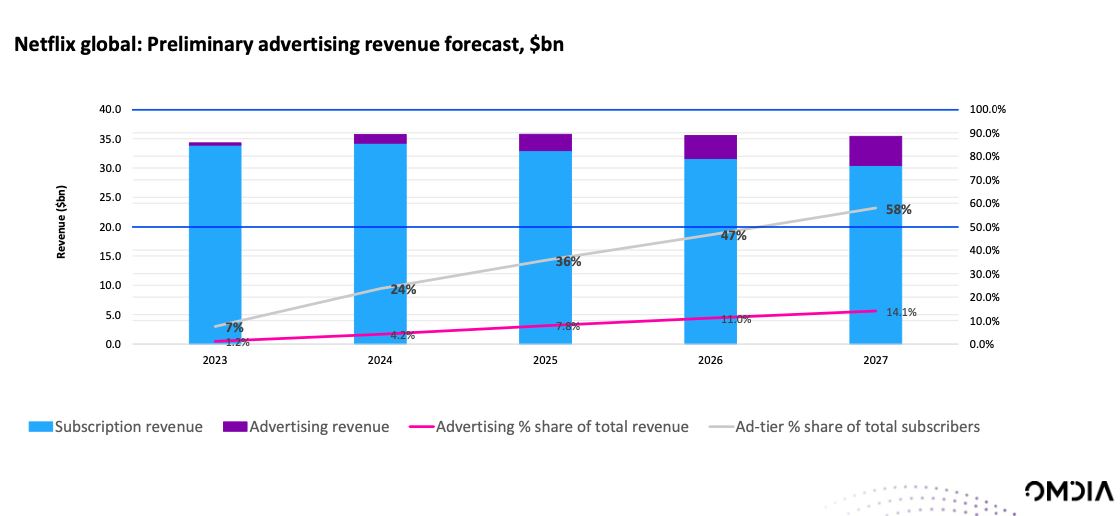
After more than 40 years of operation, DTVE is closing its doors and our website will no longer be updated daily. Thank you for all of your support.
How will Netflix’s ad-supported tier shape the streaming landscape?

Netflix will launch its long-awaited advertising-supported tier in November in an attempt to reclaim its spot atop the streaming tree.
Few details are known about how the product will look right now, but we have a slight idea. The company has reportedly set a US$7-9 per month price tag, and has set boundaries around advertising on kids content, while Netflix has selected Microsoft as its adtech partner. (When examining the world’s largest tech companies by market cap, Microsoft is the only one in the top four without a video streaming service so this, in a way, gives it an in on the action.)
What we can safely say however is that all signs point to the launch dramatically changing the makeup of Netflix itself and the wider streaming landscape.
Research house Omdia estimates that 60% of Netflix’s subscribers will be on the ad-supported tier by 2027, made up of a combination of new subscribers and existing users who will shift to the cheaper option.
Speaking on Digital TV Europe’s TV Watch podcast, Tony Gunnarsson, principal analyst TV video and advertising at the researcher, asserts that the company’s move into advertising will be no half-measure.
“I’ve been convinced that it does not make sense for Netflix to have ads here as a sort of side business,” he says. “Advertisers have been knocking on the door at Netflix for years and they do so because it has huge scale. And in order to have those negotiations with advertisers, Netflix must promise significant scale otherwise no one would buy ad space.”
An industry in change
The move came as something of a shock announcement due to a long-held ‘no ads, no sport’ mantra at the streamer. However, that was before Netflix started losing millions of subscribers and started looking for alternative ways to maintain growth outside of pure user expansion.
“We wrote in our ‘Trends To Watch 2022’ report last year that 2022 is going to be the year for hybrid models. It’s something that we’ve been saying for many years, but for Netflix two consecutive quarters of quite high levels of churn domestically is the key driver here,” Gunnarsson explains. “Wall Street is seeing that the gold standard of streaming is losing users, and the share price tumbles every time there’s a less than amazing result for Netflix.

The combined streaming portfolio of Disney – including Disney+, Hulu, ESPN+, and Hotstar – overtook Netflix for subscribers globally in August 2022
“I’ve been covering Netflix for nearly ten years and I’ve stood on a stage in front of lots of people and when asked whether Netflix will add adverts I said ‘No, why would they? They have been successful as an ad-free service that is cheap now.’ But they’re losing users domestically and that’s why they’re moving now.”
But this is part of a wider trend – particularly in the US – towards a hybrid model. All the big streaming services (bar Amazon’s Prime Video) in the country either launched with or subsequently added an ad-supported option. Paramount+, HBO Max, Peacock, Hulu and soon Disney+ all have this kind of hybrid offering in the US.
The analyst explains that pure-play SVOD services won’t go away, but these will be the smaller-scale and genre-specific services such as Mubi and Lionsgate+. “The economics of implementing advertising wouldn’t work for those,” he says. “These kinds of platforms are using SVOD as a premium model, similar to how transactional was perceived but never really took off.”
He says that the pure-play SVOD model is not going to go away, particularly in Europe where viewers are generally less receptive to advertising.
International approach
That antipathy towards advertising outside of the US will cause Netflix and others some challenges when they look to expand this model. It’s telling that, despite offering it in the US, Paramount+ launched in European territories such as Italy and the UK and Ireland without an ad-supported option.
“AVOD hasn’t been tested in Europe to the same scale as the US,” Gunnarsson says, “And the reason for that is that Europeans historically have always been much less ad tolerant than Americans. That amount of minutes of advertising in the US on pay TV channels versus in Europe is quite different.”
He explains that Netflix will look to “essentially manipulate its pricing strategy to drive people” to the ad tier and “that is how they will succeed in Europe.”
Yes, this will mean that Netflix may further increase the cost of the ad-free version of its platforms in order to entice them to take ads. The important thing to note here is that even if Netflix is not getting more immediate cash from a user, it knows that the average revenue per user (ARPU) is higher for ad-supported subscribers.
The research house predicts that a quarter of Netflix’s US revenues will come from advertising, while that proportion will drop to 15% for global revenues.
Gunnarsson concludes: “We don’t think that advertising will displace subscriptions as the main source of revenue for Netflix, but in order to do this successfully they need to go all-in; they need to restructure their marketing, their relationship with telcos and do a lot of heavy-lifting to get there.
“This is why I’ve been arguing that this is the beginning of the end for SVOD. The way we think and talk about Netflix will change, and we’ll come to think of Netflix as that service where they play you a two-minute advert in the beginning and end of shows and movies.”
The full interview with Omdia’s Tony Gunnarsson can be heard in Digital TV Europe’s TV Watch podcast, available for free via Apple Podcasts and Spotify.



